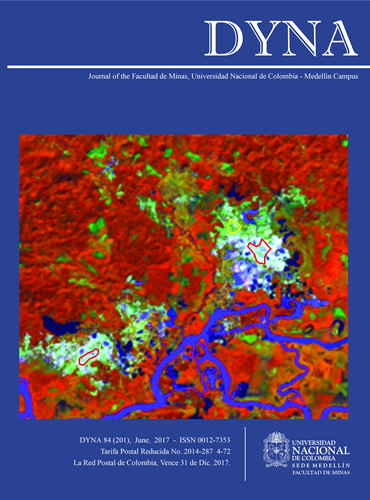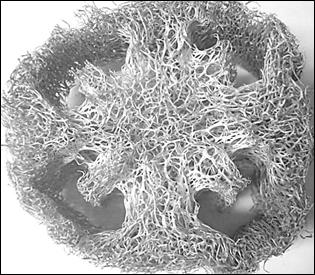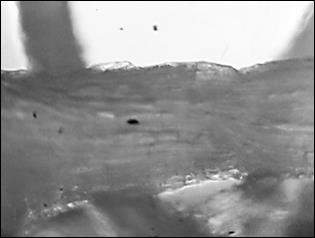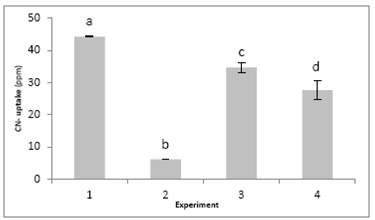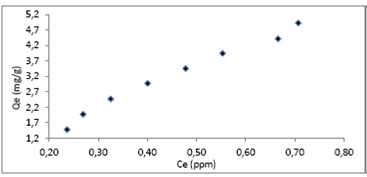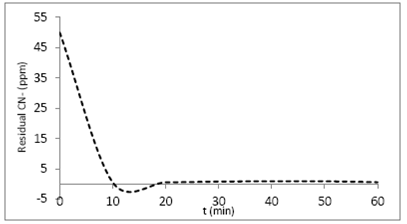Luffa Cylindrica as a natural adsorbent of cyanide ion in aqueous médium
Luffa Cylindrica como adsorbente natural de ion cianuro en medio acuoso
DOI:
https://doi.org/10.15446/dyna.v84n201.60070Palabras clave:
Adsorption, gold mining, cyanide, lignocellulosic, Luffa Cylindrica (en)Adsorción, minería aurífera, cianuro, lignocelulósico, Luffa Cylindrica (es)
Descargas
Recibido: 14 de septiembre de 2016; Revisión recibida: 24 de abril de 2017; Aceptado: 8 de mayo de 2017
Abstract
Cyanide is considered a highly toxic species for any ecosystem in as much as it causes disease in humans, contributes to the loss of soil fertility and contaminates water sources, constituting an important factor in the mortality of aquatic flora and fauna. The aim of this work is to evaluate the potential ability of the natural sponge Luffa Cylindrica as an adsorbent material to remove cyanide from aqueous medium. In order to measure the adsorption capacity the experiments were carried out through the application of a factorial experimental design that includes variables such as pH and contact time. Suitable conditions to retain the cyanide ion were pH 9.0 and a contact time of 10 minutes. The adsorption behavior is represented by the Freundlich isotherm, and the adsorption kinetics fits the pseudo-second order kinetic model. Retention rates from 12.2 to 98.0%.
Keywords:
Adsorption, gold mining, cyanide, lignocellulosic, Luffa Cylindrica.Resumen
El cianuro se considera una especie altamente tóxica para cualquier ecosistema debido a que causa enfermedades en seres humanos, contribuye a la pérdida de fertilidad en suelos y contamina fuentes de agua constituyendo un factor importante en mortalidad de flora y fauna acuática. El presente trabajo evalúa el estropajo (Luffa Cylindrica) como material adsorbente de origen natural para retener ion cianuro en medio acuoso; los ensayos realizados se llevaron a cabo a través de la aplicación de un diseño experimental tipo factorial, evaluando variables como pH y tiempo de contacto en dos niveles. Las condiciones adecuadas para retener el ion cianuro fueron pH de 9,0 y un tiempo de contacto de 10 minutos, el comportamiento adsorbente - adsorbato se representa por la isoterma de Freundlich, el modelo cinético de adsorción se ajusta a pseudo-segundo orden. Se obtuvieron porcentajes de retenciones de ion cianuro que van desde 12.2 hasta 98.0%.
Palabras Clave:
Adsorción, minería aurífera, cianuro, lignocelulósico, Luffa Cylindrica.1. Introduction
Industrial activities can generate significant loads of pollutants that are released into water sources. Gold mining uses highly toxic compounds such as cyanide [1] which is considered potentially lethal to any ecosystem. In contact with water it produces hydrocyanic acid, a compound that causes serious illnesses in humans and animals, and degradation of soil fertility. The use of cyanide in gold mining is an important cause of biodiversity depletion in developing countries such as Colombia [2].
Water quality studies have been carried out in mining areas in Colombia (i.e. Marmato - Caldas) and have reported concentrations of cyanide ion as high as 5.60 ppm [3], amounts that exceed the Threshold Limit Value - Short-term Exposure Limit (TLV - STEL) established at 4.7 ppm [4]. Current methods to remove cyanide in aqueous medium are generally expensive and not very efficient [5] since they involve modifications in the extraction process and wastewater management that implies the incorporation of equipment and reagents [6]. A practical alternative is the adsorption and removal of cyanide from aqueous media through the use of lignocellulosic materials; Luffa Cylindrica is made up of cellulose and lignin, structures that have functional groups and provide the possibility of forming bonds that favor adsorption also, natural sponge forms a fibrous network with macropores of a diameter between 10 and 20 μm, feature that, also influences the process [7]. In Colombia the Luffa Cylindrica sponge is a feasible choice to be used in cyanide removal because of its availability and low cost. On the other hand, the natural sponge can be used as a support for microorganisms that degrade cyanide [8,9]. The main objective of this study was to evaluate the natural sponge Luffa Cylindrica as an adsorbent material to retain naturally occurring cyanide in an aqueous medium. In order to obtain an efficient model, an experimental design was carried out considering the main experimental variables.
2. Materials and methods
2.1. Material pretreatment
The Luffa Cylindrica samples come from the department of Valle del Cauca - Colombia. In order to increase the material contact surface its particle size is reduced, then the raw material is washed with distilled water and dried at 80°C which removes possible interference that could influence the adsorption process and finally, the sample is homogenized at 850 µm.
2.2. Material characterization
-
An acid-base titration with standardized solutions of HCl and NaOH 0.01N, using 0.5000 g adsorbent material and point of zero charge through NaCl electrolytic medium. Sample solution amounts between 0.1000 - 0.6000g [10].
-
Spectrophotometry FTIR: an IR-Prestige Shimadzu spectrometer was used to obtain infrared spectra under ambient conditions.
-
Stereoscopic Images: samples of the wet material were observed in a binocular Leica stereoscope with 100x magnification.
-
BET area: the determination of the respective nitrogen isotherm at 77 K is performed in Quantachrome Autosorb Automated equipment.
2.3. Adsorption tests
The cyanide ion in solution was quantified by ultraviolet spectrophotometry through the formation of cyanogen chloride. Reaction with pyridine to give glutacondialdehyde in condensation with 1,3-dimethylbarbituric acid, resulting in a violet colored complex with polimetine maximum absorption at a wavelength of 585 nm.
2.4. Experimental design
The appropriate adsorption conditions of cyanide by the natural sponge were determined through a factorial experimental design 22 where we evaluated two variables in two levels: contact time (10 and 60 min) and pH (9,0 and 13) as shown in Table 1. The experiments in the research were the result of duplicates studied by analysis of variance and a Tukey test with Statgraphics plus 5.1® program. Differences were considered statistically significant when the p value was <0.05.
Source: The authorsTable 1: Factorial experimental design

2.5. Adsorption isotherms
Adsorption tests were performed at 20 °C, using 0.500 g adsorbent materials and concentrations of cyanide solutions in a range of 15 - 50 ppm.
2.6. Kinetic approach
The natural sponge - cyanide kinetic behavior was estimated by adsorption tests over a period of 60 min, performing complex readings over intervals of 10 min time.
2.7. Real matrix
The experiments were carried out in a solution which simulates the wastewater process for gold mining [11], this solution specifically includes cyanide, zinc and copper ions in concentrations of 15, 18 and 12 ppm respectively [12].
3. Results and discussion
3.1. Characterization of the adsorbent material
Luffa Cylindrica natural sponge is composed of 60% cellulose, hemicellulose 30% and lignin 20% [13], a fact that makes it a flexible and durable material. This composition reflects not only its physical-chemical characteristics but also in the material. Fig. 1a shows a porous structure composed of a thin outer layer of fibers that connect inside forming a complex network of fibers. In the stereoscopic image in Fig. 1b it can be seen that fibrils are oriented parallel to the longitudinal axis of each fiber [14].
Figure 1a: Natural sponge Luffa Cylindrica cross section
Figure 1b: Magnified fibers Luffa Cylindrica
Source: The authorsTable 2: Superficial characterization of the adsorbent material

3.1.1. Superficial chemical
Table 2 shows the quantification of acid and basic sites, which allows us to establish the superficial chemical characteristics of the material; a value of 0.84 meq/g indicates greater concentration of groups of acid character, and suggests a predominance of groups type hydroxyl and carboxyl, consisting mainly of lignocellulose that can actively intervene in the process of adsorption material.
Figure 2: Spectra FTIR natural sponge Luffa Cylindrica - Cyanide ion
The zero charge point makes reference to the total surface load and it establishes a value of 4.5 for natural sponge; it shows a positive superficial charge to solutions of lower than 4.5 pH and negative to solutions greater than this value. [10].
A relevant parameter to take into account about the material that is used as an adsorbent is the specific superficial area (BET); the considered value, turns out to be too small but coherent, since it is within the rank that is established under study for this kind of material, and whose value approximates to 1.04 m2/g [15].
The chemical structure of the absorbent material is relevant to understand the adsorption process. Identification of functional groups on the surface was carried out through the respective spectra FTIR which is in Fig. 2.
In the spectrum that corresponds to the natural sponge Luffa Cylindrica it is observed that a band at 899 cm-1 is attributed to an extension of the bond (C(C [16]. The signals that are located between 2856 and 2925 cm-1 are due to the symmetrical absorption in the bond (C(H [17]. The band located at 1736 cm-1 is due to C(O bonds, which is characterized by its acute formation and relative isolation from other bands [18]. Also, the peak at 1672 cm-1 is assigned to the presence of (NH2. The peaks ranging between 1300 and 1100 cm-1 may correspond to ketones.
The obvious difference between both spectra show the interaction between the cyanide ion and the material that is used as adsorbent, the appearance of the band in 2343 cm-1 is related to the presence of carbonyl groups, which can react with adsorbate once it is retained in the surface of the material [19].
3.2. Experimental design
The results obtained when evaluating cyanide ion retention in the natural sponge Luffa Cylindrica applying the experimental design proposed is shown in Fig. 3.
The ANOVA of factors applied to the factorial design indicated that the pH effect (p=0.00007), contact time (p=0.00689) and the interaction pH-contact time (p=0.00029) are statistically significant (p<0.05) in the retention of the cyanide ion in Luffa Cylindrica. Therefore, the results of the analyses of variance between the interactions are illustrated in Fig. 3. These indicate that the number one experiment in which the conditions correspond to contact time 10 minutes and pH 9.0 allowed to obtain the highest percentage of retention of cyanide ion. It is also possible to establish that there are statistically significant differences (p<0.05), between the experiment 1 and the other evaluated systems. Therefore, this experiment was found to be the most suitable for adsorption of ion cyanide by natural sponge.
Figure 3: Cyanide ion concentration retained in natural sponge according to the experimental design. Letters indicate statistical differences (P=0.05). The values in each experiment are the average of two determinations using standard deviation to calculate the deviation.
Figure 4: Adsorption isotherm of Luffa Cylindrica - Cyanide ion
3.3. Adsorption isotherm
Characteristics of the adsorption process of a cyanide-Luffa Cylindrica system can be observed in Fig 4; trend data indicate a typical adsorption isotherm on heterogeneous surfaces, which turn out to be representative of the Freundlich model.
It is observed that the curve continuously increases, which could indicate that it has not reached the saturation point of the material and that in principle the initial adsorbate concentrations may exceed the maximum established in mining.
Considering that in the cyanide solution pH value at a value of 9.0 the majority of adsorption behavior could be attributed to the presence of acidic basic functional groups and in the particular case of the Luffa Cylindrica to its porous structure.
Source: The authorsTable 3: Isotherms linearization parameters

Figure 5: Kinetic behavior of Luffa Cylindrica - Cyanide ion
The evaluation process of the cyanide ion adsorption in aqueous solution of lignocellulose material was carried out by using the Langmuir and Freundlich models; the corresponding linearization parameters are presented in Table 3.
The linear correlation of coefficients allows us to define the surface on which the adsorption process is carried out on the closest or equal values to the unit. Represented specifically by the Freundlich model, they establish heterogeneity of surface in the adsorbent that is used. The constant KF in this model is associated with the adsorption capacity [20], for the system under study at 7.08 mg(g-1. One important parameter is NF, since it provides favorable conditions for the adsorption process when it is over 1.0, a fact that is demonstrated in the evaluated material.
3.4. Adsorption kinetics
The kinetic behavior of the system is shown in Fig. 5; the adsorption process takes place rapidly during the first 10 minutes, after an apparent steady state occurs. It is noteworthy that between 10 and 20 minutes the graph takes the form of a potential well, which could be attributed to the material surface, composed by a diverse array of pores that are very close to each other [21].
The natural sponge-cyanide ion system was evaluated under four different conventional kinetic models, which are summarized in Table 4.
Source: The authorsTable 4: Adsorption kinetics model

Source: The authorsTable 5: Adsorption values constant rate and initial rate

The results show correlated values (R2), highly significant in the systems represented by the pseudo second order model, which could indicate that the adsorption system involves strong interactions via hydrogen bonds [22]. The values corresponding to the rate constant (K2), as well as the initial rate of adsorption (h), are shown in Table 5.
The initial rate proved to be slightly high, a fact that might suggest multiple interactions between the cyanide ion and the lignocellulose adsorbent material [23].
3.5. Real matrix
The result of a single test represented a cyanide ion retention in aqueous media of 98.2 %, which means quite high values in the real matrix, as this simulates water conditions resulting from the process of gold mining, where the presence of ions such as zinc and copper [24], may have effects in the adsorption process of the cyanide ion.
4. Conclusions
The suitable conditions to carry out the process of adsorption of the cyanide ion on natural sponge Luffa Cylindrica are pH 9.0 and an equilibrium time of 10 minutes, likewise, the system is mainly represented by the Freundlich model, which involves adsorption on heterogeneous surfaces. The kinetics adsorption of the system under study follows the pseudo- second model order. The lignocellulose material tested in the real matrix has a high retention efficiency of the ion of interest, as retention values approach 98.2 %, indicating an excellent option for treatment of water that has been contaminated with cyanide by the gold mining process.
Acknowledgements
Authors acknowledge the support from the laboratories of Chemical Engineering, Universidad Nacional de Colombia, Bogotá.
References
Referencias
Roshan, R., Gaur, A. and Balomajumder, C., Cyanide in industrial wastewaters and its removal: A review on biotreatment. Journal of Hazardous Materials, 163, pp. 1-11, 2009. DOI: 10.1016/j.jhazmat.2008.06.051
Donato, D., Nichols, O., Possingham, H., Moore, M., Ricci, P.F. and Noller, B.N., A critical review of the effects of gold cyanide-bearing tailings solutions on wildlife. Environmental International, 33, pp. 974-984, 2007. DOI: 10.1016/j.envint.2007.04.007
Alcaldía municipal de Marmato. Plan de desarrollo municipal. Plan de desarrollo municipal, 2008, 32 P.
ACGIH. Threshold limit values for chemical substances and physical agents.Cincinnati: ACGIH, 2010.
Jaramillo, J.A., Congreso Colombiano de Mineria. Mineria, cianuro y desarrollo sostenible, Medellín: Asosiacion de ingenieros de Minas de Colombia, pp. 1-31, 2011.
Muir, D.M. and Aylmore, M.G., Thiosulfate as an alternative lixiviant to cyanide for gold ores. Development in Mineral Processing, 15, pp. 541-560, 2005. DOI: 10.1016/S0167-4528(05)15022-4
Aylin, A., A natural sorbent, Luffa Cylindrica for the removal of a model basic dye. Journal of Hazardous Materials 179, pp. 658-664, 2010. DOI: 10.1016/j.jhazmat.2010.03.053
Parag, S. et al., Immobilization of Streptomyces clavuligerus on loofah sponge for the production of clavulanic acid. Bioresource Technology, 99(7), pp. 2250-2253, 2008. DOI: 10.1016/j.biortech.2007.05.004
Ogbonna, J. et al., Loofa (Luffa Cylindrica) sponge as a carrier for microbial cell immobilization. Journal of Fermentation and Bioengineering, 78(6), pp.437-442, 1994. DOI: 10.1016/0922-338X(94)90043-4
Navarrete, L.F., Giraldo, L. y Moreno, J.C., Influencia de la quimica superficial en la entalpía de inmersión de carbones activados en soluciones acuosas fenol y 4-Nitro fenol. Revista Colombiana de Quimica, [en línea]. 35(2) pp. 215-224, 2006. Disponible en: http://www.scielo.org.co/pdf/rcq/v35n2/v35n2a09.pdf
Ebel, M., Evangelou, M.W. and Schaeffer, A., Cyanide phytoremediation by water hyacinths (Eichhorniacrassipes). Chemosphere 66, pp. 816-823, 2007. DOI: 10.1016/j.chemosphere.2006.06.041
Bose, P., Bose, M.A. and Kumar, S., Critical evaluation of treatment strategies involving adsorption and chelation for wastewater containing copper, zinc and cyanide. Advances in Environmental Research, pp. 179-195, 2002. DOI: 10.1016/S1093-0191(01)00125-3
Rowell, R., Han, J. and Rowell, J., Characterization and factors affecting fiber properties. Natural Polymers and agrofibers based composites, [online]. pp. 115-127, 2000. Available at: https://www.fpl.fs.fed.us/documnts/pdf2000/rowel00b.pdf
Qiang, C. et al., A multiscale study on the structural and mechanical properties of the luffa sponge from Luffa cylindrica plant. Journal of Biomechanics 47, pp. 1332-1339, 2014. DOI: 10.1016/j.jbiomech.2014.02.010
Moussavi, G. and Khosravi, R., Removal of cyanide from wastewater by adsorption onto pistachio hull wastes: Parametric experiments, kinetics and equilibrium analysis. Journal of Hazardous Materials, 183, pp. 724-730, 2010. DOI: 10.1016/j.jhazmat.2010.07.086
Kaur, I., Kumar, R. and Sharma, N., A comparative study on the graft copolymerization of acrylic acid onto rayon fiber by a ceric ion redox system and y-radiation method. Carbohydrate Research, 345(15), pp. 2164-2167, 2010. DOI: 10.1016/j.carres.2010.06.018
Mishra, S. and Sen, G., Microwave initiated synthesis of polymethyl-methacrylate grafted guar (GG-g-PMMA). International Journal of Biological Macromolecules, 48(4) pp. 688-694, 2011. DOI: 10.1016/j.ijbiomac.2011.02.013
Kalia, S., Kumar, A. and Kaith, B.S., Sunn hemp cellulose graft copolymers polyhydroxybutyrate composites: Morphological and mechanical studies. Advanced Material Letters, 2(1), pp. 17-25, 2010. DOI: 10.5185/amlett.2010.6130
Gupta, N., Balomajumder, C. and Kumar, V., Adsorption of cyanide ion on pressmud surface: A modeling approach. Chemical Engineering Journal, 191, pp. 548-556, 2012. http://doi.or/10.1016/j.cej.2012.03.028
Vázquez, I., Rodríguez-Iglesias, J., Marañón, E., Castillón, A. and L., M. Removal of residuals phenols from coke waste water by adsorption. Journal of Hazardous Materials, 147(1-2), pp. 395-400, 2007. DOI: 10.1016/j.jhazmat.2007.01.019
Jímenez, M.C., Soto J. y Villaescusa, L.A., Química física para ingenieros químicos. Universidad Politécnica de Valencia,Valencia, España, 2006.
Herrejón-Figueroa, M.L. y Limón-Rodriguez, B., Cinética e isotermas de adsorción de Pb(II) en suelo de Monterrey. Ingenierías, [en línea]. XI (41), pp. 24-31, 2008. Disponible en: http://www.ingenierias.uanl.mx/41/index.html
Murillo, Y.S., Giraldo, L. y Moreno, J.C., Determinación de la cinética de adsorción de 2,4 - Dinitrofenol en carbonizado de hueso bovino por espectrofotometría UV-VIS. Revista Colombiana de Química, [en línea]. 40(1), pp. 91-103, 2011. Disponible en: http://www.scielo.org.co/pdf/rcq/v40n1/v40n1a07.pdf
Barak, M.A., Adsorption behavior of copper and cyanide ions at TiO2-solution interface. Journal of Colloid and Interface Science, 291, pp. 345-352, 2005. DOI: 10.1016/j.jcis.2005.05.047
Cómo citar
IEEE
ACM
ACS
APA
ABNT
Chicago
Harvard
MLA
Turabian
Vancouver
Descargar cita
CrossRef Cited-by
1. Ioannis Anastopoulos, Ioannis Pashalidis. (2019). Τhe application of oxidized carbon derived from Luffa cylindrica for caffeine removal. Equilibrium, thermodynamic, kinetic and mechanistic analysis. Journal of Molecular Liquids, 296, p.112078. https://doi.org/10.1016/j.molliq.2019.112078.
2. Soheil Tavassoli, Setareh Cheraghi, Pardis Etemadifar, Afsaneh Mollahosseini, Shirin joodaki, Niloofar Sedighi. (2024). Optimization and characterization of silver nanoparticle-modified luffa for the adsorption of ketoprofen and reactive yellow 15 from aqueous solutions. Scientific Reports, 14(1) https://doi.org/10.1038/s41598-024-54790-7.
3. Ioannis Anastopoulos, Ioannis Pashalidis. (2020). Environmental applications of Luffa cylindrica-based adsorbents. Journal of Molecular Liquids, 319, p.114127. https://doi.org/10.1016/j.molliq.2020.114127.
4. Obradith Caicedo, Jency Devia-Ramirez, Andrés Malagón. (2018). Adsorption of Common Laboratory Dyes Using Natural Fibers from Luffa cylindrica. Journal of Chemical Education, 95(12), p.2233. https://doi.org/10.1021/acs.jchemed.8b00156.
5. Kenechi Nwosu-Obieogu, Goziya W. Dzarma, Precious Ehimogue, Chijioke B. Ugwuodo, Linus I. Chiemenem. (2022). Textile wastewater heavy metal removal using Luffa cylindrica activated carbon: an ANN and ANFIS predictive model evaluation. Applied Water Science, 12(3) https://doi.org/10.1007/s13201-022-01575-w.
6. Ali Khadir, Mehrdad Negarestani, Afsaneh Mollahosseini. (2020). Sequestration of a non-steroidal anti-inflammatory drug from aquatic media by lignocellulosic material (Luffa cylindrica) reinforced with polypyrrole: Study of parameters, kinetics, and equilibrium. Journal of Environmental Chemical Engineering, 8(3), p.103734. https://doi.org/10.1016/j.jece.2020.103734.
7. Kenechi Nwosu‐Obieogu, Bernard I Okolo. (2020). Biosorption of chromium (VI) from textile waste water using luffa cylindrica activated carbon. Environmental Quality Management, 29(4), p.23. https://doi.org/10.1002/tqem.21687.
8. Sanjay B. Bhagwat, Dipika Jaspal. (2022). Textile Wastewater Treatment. Sustainable Textiles: Production, Processing, Manufacturing & Chemistry. , p.71. https://doi.org/10.1007/978-981-19-2852-9_5.
9. Ali Khadir, Mahsa Motamedi, Ebrahim Pakzad, Mika Sillanpää, Shreya Mahajan. (2021). The prospective utilization of Luffa fibres as a lignocellulosic bio-material for environmental remediation of aqueous media: A review. Journal of Environmental Chemical Engineering, 9(1), p.104691. https://doi.org/10.1016/j.jece.2020.104691.
10. Soheil Tavassoli, Afsaneh Mollahosseini, Saeed Damiri, Mehrshad Samadi. (2025). Luffa–Ni/Al layered double hydroxide bio-nanocomposite for efficient ibuprofen removal from aqueous solution: Kinetic, equilibrium, thermodynamic studies and GEP modeling. Heliyon, 11(1), p.e40783. https://doi.org/10.1016/j.heliyon.2024.e40783.
Dimensions
PlumX
Visitas a la página del resumen del artículo
Descargas
Licencia
Derechos de autor 2017 DYNA

Esta obra está bajo una licencia internacional Creative Commons Atribución-NoComercial-SinDerivadas 4.0.
El autor o autores de un artículo aceptado para publicación en cualquiera de las revistas editadas por la facultad de Minas cederán la totalidad de los derechos patrimoniales a la Universidad Nacional de Colombia de manera gratuita, dentro de los cuáles se incluyen: el derecho a editar, publicar, reproducir y distribuir tanto en medios impresos como digitales, además de incluir en artículo en índices internacionales y/o bases de datos, de igual manera, se faculta a la editorial para utilizar las imágenes, tablas y/o cualquier material gráfico presentado en el artículo para el diseño de carátulas o posters de la misma revista.



